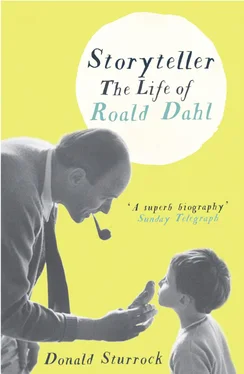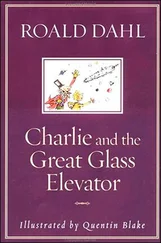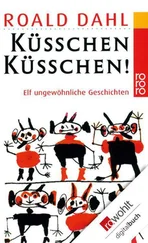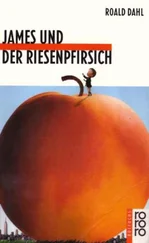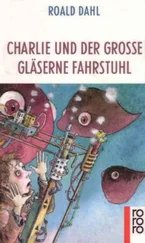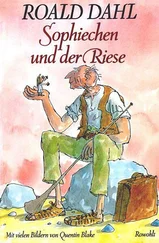When he returned to Weston-super-Mare, Roald gradually began dealing with his homesickness. His main salvation was sport, something which the boys did almost every day and at which he showed a natural talent. His height and ranginess made him a good rugby player and a competent footballer, cricketer and boxer, though his school report for the summer of 1926 describes him as “overgrown” and “slow”. 31His weekly letters home to his mother, however, are brimful of his sporting exploits: swimming lengths of the pool underwater, learning to ride horses, scoring goals in soccer and striking boundaries in cricket. “I hit two sixes,” he writes at one point, explaining dramatically to his mother that “you get a six when the ball goes full pitch into the boundary. One hit the pavilion with a tremendous crash and just missed a window.” 32His height was blamed for a “ponderous” 33boxing technique, as were a number of other problems. Sent to a local optician because of recurrent headaches, he was told that there was nothing wrong with his eyes, but that he was “run down, due to growing too quickly”. 34
The academic standards at St Peter’s were high and, initially, Roald was thrown in with a group of boys, including Douglas Highton, who were mostly a year and a half older than he was. He struggled to keep up, finding arts subjects — particularly languages — difficult. A report from Easter 1927 described him as “a little on the defensive” and exhorted him “to have more confidence”. “He imagines he is doing badly,” the report continued, “and consequently does badly.” 35So in September 1927 he stayed down in the 4th Form for a term, regaining his self-esteem and earning a record number of stars for Duckworth Butter-flies. †But when he was promoted back to the higher year, things once more became academically difficult and again he became withdrawn. Douglas Highton, whose family lived in Asia Minor, and who was one of the most academic boys in the school, remembered Dahl as an outsider, with few friends. “Roald had a different individuality … he was very much an immigrant from Norway, and I was an immigrant from Turkey, where my mother’s family had been established for about two hundred years. We were both foreigners.” The two misfits became firm friends, walking side-by-side on school trips to Weston-super-Mare, and indulging their mutual contempt for “what we regarded as stupid or unnecessary rules”. They saw themselves as “subversives”, developing a love of word games, enjoying a similar sense of humour, and sharing a sense of “the ridiculous nature of the English”. A sprightly ninety-three when I spoke to him, Highton remembered that — even as a nine-year-old — his friend could be stubborn and dogmatic, “but I didn’t mind,” he continued. “I knew as soon as I met him, this was a chap I wanted to be with.” 36
Roald’s letters home from St Peter’s were always written in English, and he later recalled that after the family’s Norwegian nurse left their employment in the mid-1920s, “the whole household started going over to English”. 37For his first year he always signed himself “Boy”. It was the way he had defined himself in a house full of women and it was not until he was almost ten that he started to call himself Roald. The letters reveal many of the enthusiasms that would continue into later life: natural history, collecting (initially stamps and birds’ eggs), food (mostly sweets and chocolates) and sport, where perhaps his most impressive achievement was at conkers. ‡Highton remembers that Roald was an “ace” — selecting his chestnuts “with great care and technical skill” and inventing a process to harden them “to such a degree of indestructibility that he almost always won”. 38One year he was the school champion, writing home to his mother with pride that he had “the highest conker in the school — 273”. 39
His tone to her was usually confident, often bossy, and his letters are full of detailed and highly specific instructions and requests. “I’m sending some things out of Toblerone chocolate, if you collect forty of them you get shares in the company,” 40he writes at one point, complaining bitterly at another that the toy submarine she has bought him from Harrods does not dive properly. In this context his mind strays to the store’s famous pet department and he wonders how much a monkey might cost. “It would be rather nice to have one,” he suggests hopefully. 41Indeed, Roald often seemed more concerned about the well-being of his pets — which included turtles, dogs, rats, tortoises and a salamander — than he was about his family. His occasional letters to his sisters are generally brief and often patronizing. When Alf got a place at Roedean, for example, Roald merely commented: “What a miracle Alfhild has passed … she was jolly lucky; personally I didn’t think she would.” 42
Roald was part of a generation of British children for whom the natural world was a source of immense stimulation and pleasure. As he grew up, he was constantly observing the countryside around him — noting unusual phenomena and picking up anything that attracted his attention. His collection of 172 birds’ eggs, lovingly preserved in a glass cabinet with ten drawers, ranged from a tiny wren’s to those of hawks, gulls and carrion crows. The eggs were things of great beauty for him, each with its own unique colours and speckles. Some were collected from sheer cliff faces, others from the tops of tall trees, and he recalled them with great affection. “I could always remember vividly how and where I had found each and every egg,” he wrote a few months before he died, adding that he thought collecting eggs was “an enthralling hobby for a young boy and not, in my opinion, in the least destructive. To open a drawer and see thirty different very beautiful eggs nestling in their compartments on pink cotton-wool was a lovely sight.” 43
In childhood, Roald’s curiosity about the world was insatiable, and his letters from St Peter’s reveal clearly how much the natural world meant to him. The “snow-white passages” and “beautiful fossils” in the nearby Mendip caves 44counterpoise a lecture on bird legends, in which the boys are told how the thieving blackbird got its black plumage and yellow beak, and — this appealed to him most — how the tiny wren defeated the eagle to become king of the birds. As a correspondent, he treats his mother as someone constantly in need of education, earnestly recounting what he has learned in school: how owls spew up the remains of the food they’ve eaten in pellets, 45how kangaroos box, and how, in Nigeria, “black people live in mud huts”. 46An eclipse of the sun, which he views through special glasses he has got from a children’s newspaper, fascinates him, 47as does the precise means of making fire with wood and a piece of cord. 48And just in case Sofie Magdalene can’t quite grasp it, he makes a careful series of drawings and diagrams for her. His sense of adventure and curiosity is constantly stimulated. A film of the pilot Alan Cobham’s flight to the Cape of Good Hope, 49a lecture by Captain Morris who has been on an expedition to Mount Everest, 50and a newsreel about travelling from Tibet to India in a motorcar, 51compete with a school trip to the caves of the Cheddar Gorge, a nearby local attraction, in a charabanc, where the boys were squashed into the open-topped coach “like sardines in a tin”. 52Fire too is another source of wonder and always exciting — even when Roald’s hand is badly burned by a “jackie jumper” firework. 53And, when three shops burn down in the local town, the masters lead a school expedition there the following day so that the boys can inspect the smouldering ruins. 54
Despite its Spartan discipline, the school exposed its pupils to the classics, to literature and to music. At home Roald had begun by reading Beatrix Potter stories, moving on to A. A. Milne, Frances Hodgson Burnett’s The Secret Garden, which he would later describe as “the most enduring of all children’s books”, and the fairy tales of Hans Christian Andersen. Hilaire Belloc’s Cautionary Verses, however, were the first to leave “a permanent impression”. 55They made him laugh, and by the age of nine he had learned them all by heart. St Peter’s pushed him further. By the time he was twelve, Roald was familiar with compositions by Beethoven, Mozart, Tchaikovsky and Grieg, 56and had encountered many of Shakespeare’s plays, three Dickens novels, Stevenson’s Treasure Island? 57and a great deal of Rudyard Kipling. He was already very comfortable with literature. There were books at home and his mother was an avid reader — Horace Walpole, Thomas Hardy and G. K. Chesterton were among her favourites.
Читать дальше
